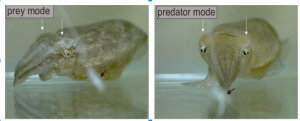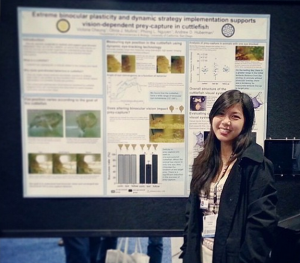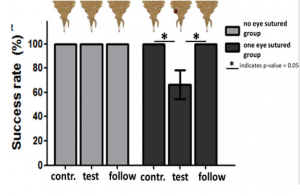By Lawrence Liu | UTS Staff Writer | SQ Online (2014-15)
A fundamental goal of neuroscience is to discover how neurons work together to help an organism survive in its environment. In the Huberman Lab at UC San Diego, undergraduate researcher Victoria Cheung studies cuttlefish for experimentation and data analysis to to better understand neural mechanics of vision in humans.
Cuttlefish are cephalopods that are closely related to octopuses and squid. These animals were around even before fish evolved. While they do have cuttlebones to protect themselves, cuttlefish mainly utilize two strategies for defense: camouflage and eyesight. Cuttlefish skin is filled with chromatophores, or pigment cells. Cuttlefish utilize these chromatophores to camouflage with its environment when threatened, but also to communicate with other cuttlefish by utilizing their intricate nervous systems. This physiological capability makes researchers consider cephalopods the most intelligent mollusks in the sea.
Cuttlefish are known for their ability to camouflage. Many experiments have been done in which artificial environments are constructed to model how the cuttlefish is able to blend in with its surroundings. By understanding how these chromatophores work, we can potentially create commercial or military sheets that can hide objects.
Cuttlefish eyesight is interesting for two reasons. First, eyesight is key to cuttlefish survival. By utilizing eyesight in addition to camouflage, they are able to increase their survival. Second, the complex network of neurons utilized when cuttlefish track prey can help us better understand how human eyesight works as well. However, there is currently little to no research on how eyesight plays a role in cuttlefish survival.


Cheung conducted one of the first experiments designed to understand cuttlefish eye tracking. She imaged the advanced eye movements, showing that many brain regions are utilized.
An initial challenge was to determine the range of binocular overlap, the overlap of vision from each eye. This was measured using two high-speed cameras. One camera was placed at the level of the cuttlefish, while the other was placed above the cuttlefish. Furthermore, a semi-automated eye tracking software was used to generate 3D positional coordinates to calculate the difference in angle between the cuttlefish eyes.
Data suggest that there is a wide range of overlap, from 15 to 100 degrees. This is quite significant, as it shows that the cuttlefish can utilize not only straight and vertical but also peripheral views. There is a potential neural switch in the transition from peripheral vision to frontal vision.

Further experiments were done to see just how important eyesight is for cuttlefish survival. One eye of the cuttlefish was sutured shut after administration of anesthesia. The results show that the cuttlefish were not as efficient in capturing their prey since their tentacles missed the target. The results suggest that depth perception is heavily utilized in survival and was heavily impaired by suturing. Typically, visual input from each eye merges into a single image, generating depth perception. The eyes of the cuttlefish allow for a wide range of binocular overlap, and upon removing one, prey capture success rates dropped.
By understanding how the visually adapted cuttlefish utilizes binocular vision, we can understand more about how our visual system is wired to support our reliance on depth perception to better navigate the visual world. We can utilize the cuttlefish’s evolutionary development in eyesight to better understand how human vision developed.
[hr gap=”0″]
Sources:
- Cheung, Victoria, Mullins, Olivia. “What is the neural circuit organization supporting flexible eye movements?”. SACNAS, San Antonio, Texas. Oct 3. 2013
- http://www.pbs.org/wnet/nature/animal-guides/animal-guide-cuttlefish/1161/
- http://www.ncbi.nlm.nih.gov/pubmed/25136094
- https://www.youtube.com/watch?v=GDwOi7HpHtQ


